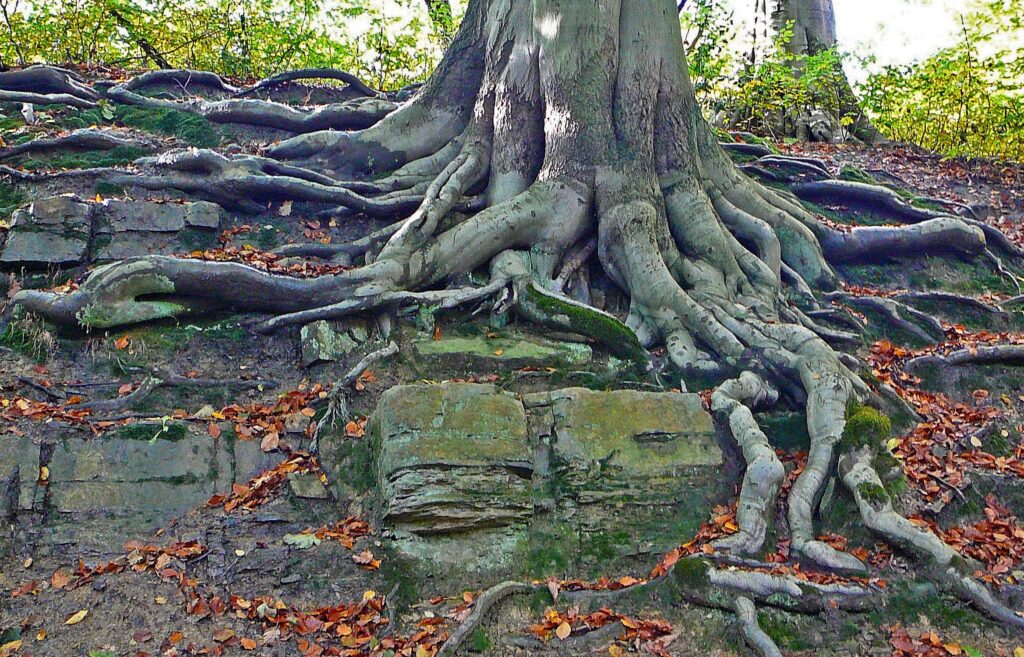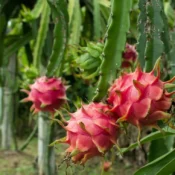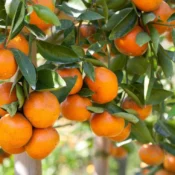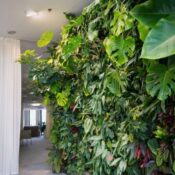
You might have heard that some trees have aggressive (invasive) roots, capable of destroying buried pipes, sidewalks, pavements, walls, etc. I don’t believe roots are truly aggressive; they don’t mean harm, they are just vigorous and grow superficially, thickening over time and eventually resulting in catastrophic effects in urban environments. What actually happens is a poor choice of species often accompanied by improper planting. Not every beautiful tree, with spectacular flowering, is suitable for paved areas, parking lots, and small backyards.

They are perfect for being admired in all their majesty in large open areas, such as parks, squares, and farms. Keep in mind, even the recommended species need a minimum water absorption area in the bed to avoid aggressive roots in the future. Moreover, it is useless to insist on these species by planting them inside concrete culverts. You will be distorting the nature of the tree, hindering its development and yet its roots will destroy the culverts over time, emerging a bit further away.
Below is a list of tree species commonly found in large cities, but that may represent a significant inconvenience to buildings and people, whether because of their invasive roots, or because of large and heavy fruits, slippery leaves or flowers, dangerous natural pruning, fragile trunk susceptible to termites, among other issues. Before removing a tree for any of these reasons, request a technical evaluation from an agronomic or forestry engineer to verify if there are indeed problems or if there will be in the future.


- Weeping Willow – Salix x pendulina: Unsuitable crown for sidewalks, obstructs pedestrians. In search of water, weepers tend to destroy buried water and sewage pipes.
- Flamboyant – Delonix regia: Tabular roots, very superficial and aggressive.
- Ficus – Ficus benjamina: Reaches large dimensions. Never stops growing. Has superficial and adventitious roots.
- Pink Silk Floss Tree – Ceiba speciosa: A vigorously growing, large tree, that has fragile wood, a trunk covered in thorns. Prone to breaking.
- Ant Tree – Triplaris americana: Lightweight wood, superficial roots, large dimensions, and attracts ants.
- Eucalyptus – Eucalyptus spp: Most species are large, with superficial root systems and natural shedding.
- Avocado – Persea americana: Tree with fragile wood, prone to breaking and can reach large sizes. Large fruits cause mess.
- Mango – Mangifera indica: Superficial root system, large fruits cause a lot of mess.
- Guapuruvu – Schizolobium parahyba: A tree with rapid growth and large size. Very fragile wood, prone to falls and branch breakage.
- Paraná Pine – Araucaria angustifolia: Native tree of large dimensions, its biggest problem is natural shedding. In places with many specimens, a pruning program is recommended to avoid shedding. Susceptible to termites.
- Jackfruit – Artocarpus heterophyllus: Tree with giant fruits that can cause serious accidents, falling on cars and injuring people.
- Indian Almond – Terminalia catappa: Superficial root system. Canopy can reach large dimensions.
- Casuarina – Casuarina equisetifolia: Superficial roots.
- London Plane – Platanus x hispanica: Large size and superficial roots. Requires annual pruning and its leaves cause a lot of mess. Trunk susceptible to borers.
- African Tulip Tree – Spathodea campanulata: Flowers with toxic pollen to bees. When they fall, the flowers are mucilaginous and slippery. Superficial roots.
- Silky Oak – Grevillea robusta: Superficial and vigorous root system.
- Tipuana – Tipuana tipu: Large size, aggressive roots, and fragile wood, which is more prone to breaks and termites.
- Black Poplar – Populus nigra: Aggressive roots.
- Monkey Pot – Couroupita guianensis – Also known as cannonball tree. Its fruits are large, heavy, and smelly, can cause accidents and a lot of mess.
- ubber Fig – Ficus elastica: Like other fig trees, it has a large diameter trunk, adventitious and superficial roots.
- Pine – Pinus spp: Many large species, susceptible to termites and with natural shedding.
- Java Plum – Syzygium jambolanum – The fall of its small fruits causes a lot of mess on pavements, parking areas, and on cars.

Fig trees of different species are known for destroying buildings. Temple in ruins. -

Dangerous and smelly. The fruits of the Monkey Pot are real cannonballs. Photo by Wendy Cutler Norway Maple – Acer platanoides: Valued for its robustness and dense foliage that provides intense shade, but its superficial root system can damage sidewalks and pipes, in addition to inhibiting the growth of other plants around it due to the intense shade.
- Black Locust – Robinia pseudoacacia: With extremely hard and resistant wood, it can become invasive due to its strong roots and shoots, making control difficult in urban environments.
- Bradford Pear – Pyrus calleryana ‘Bradford’: Attractive for its shape and white spring flowers, it has problems with fragile wood that easily breaks in storms and its invasive nature.
- Sycamore – Platanus occidentalis: Valued for its majestic presence and generous shade, its superficial roots can damage urban infrastructures, and its large leaves can clog drainage systems.
- Sweetgum – Liquidambar styraciflua: Known for its beautiful fall color, the spiny seeds that fall represent a nuisance for circulation and leisure areas, and its roots can damage pavements.
- Banyan Tree – Ficus benghalensis: Impressive in size and beauty, its aerial roots and extensive root system can cause serious damage to buildings and pavements, requiring ample space for proper growth.
- London Plane – Platanus × acerifolia: A hybrid resistant to pollution, common in urban environments, yet its large size, expansive root system, and need for frequent pruning pose challenges in limited urban spaces.
- American Cottonwood – Populus deltoides: Known for rapid growth and large size. Its aggressive roots can damage sidewalks and foundations. Fragile wood increases the risk of breaks during storms.
- Bigtooth Aspen – Populus grandidentata: This tree has a robust root system that presents challenges in urban environments. Careful site selection is necessary to avoid damage to infrastructure.
- Quaking Aspen – Populus tremuloides: Notable for leaves that tremble in the wind, has a superficial and expansive root system that can interfere with paved surfaces. It proliferates, potentially invading areas.
- Silver Maple – Acer saccharinum: Valued for its rapid growth and silver foliage, its expansive roots can damage sidewalks and buried pipes. Its wood is also somewhat fragile, posing a risk during strong winds.
- Camphor Tree – Cinnamomum camphora: Fast-growing tree with dense foliage, known for its aggressive roots that can cause damage to buildings and pavements. Its wood is aromatic, but the tree can become invasive in some environments.
- White Poplar – Populus alba: With superficial and extensive roots, the white poplar can lift sidewalks and damage urban infrastructures. Its wide canopy and silver foliage are decorative, but require adequate space for growth.
- Andean Birch – Alnus acuminata: This species, adaptable to different soil conditions, has a deep root system that may be less invasive. However, its height and growth potential should be considered when planting in urban areas.
- Tipu Tree – Tipuana tipu: A large, fast-growing tree with roots that can be aggressive towards sidewalks and nearby structures. Its spectacular yellow flowering is eye-catching, but careful site planning is required.
- Magnolia – Magnolia grandiflora: Known for its large and fragrant white flowers, this magnolia can reach large dimensions, requiring enough space for development. Its roots, although less aggressive than those of other species listed, still require attention when planted near buildings.
- Fiddle-leaf Fig – Ficus lyrata: This beautiful tree, which has been greatly popular in indoor environments, similar to Ficus (Ficus benjamina), could become a big problem in the future, as people tend to plant trees that are too large for interiors in the garden. Like many fig tree species, the Ficus lyrata has an invasive and superficial root system, with great potential to destroy pavements and buried structures.
Despite the challenge of aggressive roots reminding us of the need for caution in selecting tree species for urban environments, keep in mind that the solution definitely does not lie in abolishing the presence of trees from our cities. On the contrary, a careful and informed selection of trees can mitigate these problems, allowing us to fully enjoy their numerous benefits.
Urban trees are vital for reducing air pollution, provide shade that reduces the heat island effect, increase biodiversity, and significantly improve the psychological well-being of city dwellers. These ecological and social benefits reinforce the importance of integrating trees into the urban landscape, but in a way that balances the needs of the built environment with those of nature. By making informed and conscious choices, we can create urban spaces that are both green and habitable, ensuring future generations inherit sustainable, resilient, futuristic, and vibrant cities.

See also: 35 Ideal Trees for Sidewalks








